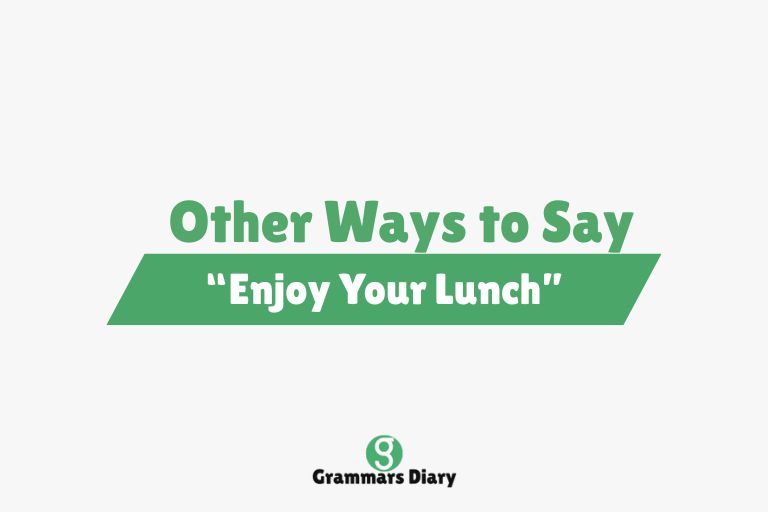“Enjoy your lunch” is one of those pleasant phrases we use every day, whether we’re sending a coworker off on their break, texting a friend mid-day, or chatting with a loved one during lunchtime. It’s a simple, polite expression that shows you care, but if you’re someone who communicates a lot — in person, in messages, or in professional settings — repeating the same phrase can start to feel a little stale.
That’s why it’s useful to have a few alternatives up your sleeve. From formal and cheerful to casual and fun, there are many ways to wish someone well as they sit down for their meal. This article will walk you through 27 other ways to say “Enjoy your lunch,” complete with meanings, sample sentences, and usage suggestions to help you express your message with variety and warmth.
Other Ways to Say “Enjoy Your Lunch”
1. Hope you have a tasty lunch
Example: “Hope you have a tasty lunch today — treat yourself!”
Meaning: A casual and warm wish for a delicious meal.
Usage: Perfect in friendly chats or informal emails.
2. Bon appétit
Example: “Bon appétit! That sandwich looks amazing.”
Meaning: French for “enjoy your meal,” often used in English as a cheerful way to wish someone well at mealtime.
Usage: Suitable for all kinds of conversations, adding a bit of flair.
3. Enjoy your meal
Example: “Enjoy your meal — let me know how the pasta turns out!”
Meaning: A direct synonym, slightly more formal or neutral than “enjoy your lunch.”
Usage: Appropriate in both personal and professional settings.
4. Have a delicious lunch
Example: “Have a delicious lunch — hope it hits the spot!”
Meaning: Emphasizes the taste and pleasure of the food.
Usage: Friendly and upbeat, great in social messages.
5. Don’t forget to eat well
Example: “Don’t forget to eat well — you’ve been working nonstop.”
Meaning: A gentle reminder to prioritize nourishment and health.
Usage: Thoughtful tone, ideal for someone who’s stressed or busy.
6. Treat yourself to something good
Example: “It’s been a tough morning — treat yourself to something good at lunch.”
Meaning: Encourages self-care and indulgence, especially after a long day.
Usage: Uplifting message for friends or coworkers.
7. Hope your lunch break is relaxing
Example: “You deserve a quiet moment — hope your lunch break is relaxing.”
Meaning: Goes beyond food and focuses on the rest and pause lunch can offer.
Usage: Kind sentiment to show empathy and encouragement.
8. Grab something yummy
Example: “I’m about to eat — grab something yummy too!”
Meaning: Fun and lighthearted way to prompt someone to enjoy tasty food.
Usage: Very informal, suited to close friends or texts.
9. Refuel with something delicious
Example: “Lunch time! Go refuel with something delicious before your next call.”
Meaning: Combines the idea of rest and energy-boosting through good food.
Usage: Perfect in work settings or fitness-related chats.
10. Take a real break and eat something nice
Example: “Don’t just snack at your desk — take a real break and eat something nice.”
Meaning: A reminder to slow down and enjoy lunch mindfully.
Usage: Encouraging tone for coworkers or friends prone to skipping meals.
11. Hope it’s something you love
Example: “Whatever you’re eating today, I hope it’s something you love.”
Meaning: Focuses more on personal enjoyment and food preference.
Usage: Friendly and flexible for all settings.
12. Savor every bite
Example: “That smells amazing — savor every bite!”
Meaning: Encourages slowing down and truly enjoying the food.
Usage: Often used in contexts where the food is special or homemade.
13. Enjoy your lunch break
Example: “Your meeting’s done — now enjoy your lunch break while it lasts.”
Meaning: Combines the idea of eating and taking a pause from work.
Usage: Common in work emails and casual workplace chat.
14. May your lunch be satisfying
Example: “Hope that salad fills you up — may your lunch be satisfying.”
Meaning: A formal or polite way to wish someone a fulfilling meal.
Usage: Slightly formal, yet versatile for multiple settings.
15. Have a nice lunch
Example: “Heading out? Have a nice lunch!”
Meaning: Simple and neutral, but still thoughtful.
Usage: Can be used in everyday speech, messages, and casual emails.
16. Fill up and feel good
Example: “Fill up and feel good — you’ve earned it today.”
Meaning: Encourages nourishment and self-care.
Usage: Friendly and emotionally supportive, great for friends or team members.
17. Take a well-deserved break
Example: “Take a well-deserved break and enjoy your meal.”
Meaning: Acknowledges the person’s effort or busyness and urges them to pause.
Usage: Works well in workplace emails or texts to coworkers.
18. Hope your lunch hits the spot
Example: “Let me know how that new restaurant is — hope your lunch hits the spot!”
Meaning: Focuses on satisfaction and fulfilling a craving or hunger.
Usage: Playful, conversational tone for casual chats.
19. Eat something that makes you happy
Example: “Feeling low? Eat something that makes you happy.”
Meaning: A comforting phrase that connects food with emotional well-being.
Usage: Gentle and empathetic, often used among friends or family.
20. Chow down
Example: “You’re starving — go chow down!”
Meaning: A fun and informal way to say “eat” enthusiastically.
Usage: Very casual, often humorous; not suitable for formal use.
21. Dig in
Example: “Food’s ready — dig in!”
Meaning: A warm and casual invitation to begin eating.
Usage: Common in family or friendly meal settings.
22. Take time to enjoy your food
Example: “Don’t rush — take time to enjoy your food today.”
Meaning: Emphasizes mindfulness and taking a break.
Usage: Supportive and encouraging, good in caring messages.
23. Sit back and enjoy your lunch
Example: “Put your phone down and sit back and enjoy your lunch.”
Meaning: Promotes relaxation and full presence during a meal.
Usage: Friendly advice, often used with people you know well.
24. Hope it’s packed with flavor
Example: “I saw your bento box — hope it’s packed with flavor.”
Meaning: Celebrates the taste aspect of lunch.
Usage: Playful and food-focused, suitable for food lovers or social media captions.
25. Bon lunch!
Example: “Bon lunch! (Okay, I just made that up but you get the vibe!)”
Meaning: A fun, light-hearted twist on “Bon appétit.”
Usage: Humorous and casual, adds a personal tone.
26. Wishing you a flavorful lunch
Example: “Wishing you a flavorful lunch — that curry sounds amazing!”
Meaning: Focuses on taste and enjoyment.
Usage: Suitable for messages, posts, or comments with food involved.
27. Nourish yourself well
Example: “It’s been a hectic morning — go nourish yourself well.”
Meaning: Highlights food as a form of care and support.
Usage: Warm and thoughtful, often used in emotional or mental health contexts.
When to Use Different “Enjoy Your Lunch” Alternatives
In Casual Conversations
When you’re texting a friend, chatting in person, or messaging someone you know well, feel free to use informal and expressive phrases like “chow down,” “grab something yummy,” or “hope it hits the spot.” These are friendly and low-pressure, adding a sense of warmth and playfulness to the exchange.
In Professional or Workplace Settings
For colleagues or professional contacts, especially in emails or Slack messages, it’s best to choose respectful and neutral options such as “have a nice lunch,” “enjoy your lunch break,” or “refuel with something delicious.” These convey your good intentions without crossing into overly casual territory.
In Friendly or Social Texts
Whether you’re talking to a family member, your partner, or someone on social media, phrases like “treat yourself to something good,” “eat something that makes you happy,” or “savor every bite” add a little emotional touch that shows you genuinely care. These phrases combine the idea of enjoying food with emotional connection and support.
Conclusion
The phrase “Enjoy your lunch” is kind and classic — but with 27 creative alternatives now in your vocabulary, you’ll be able to say it in ways that fit every mood, setting, and relationship. Whether you’re aiming for warmth, encouragement, playfulness, or professionalism, switching up your expression keeps your communication engaging and thoughtful.
So next time someone’s heading off for lunch, pick a phrase that suits the moment — and say it like you mean it.
FAQs
What does “Enjoy your lunch” mean?
It’s a polite and friendly way of wishing someone a good experience while they eat lunch, showing care or courtesy.
Is “Bon appétit” too fancy to use in English?
Not at all — “Bon appétit” is commonly used in English-speaking countries and adds a pleasant international flair.
Can these alternatives be used in professional settings?
Yes, but some are more suitable than others. Stick to phrases like “Have a nice lunch,” “Enjoy your lunch break,” or “Refuel with something delicious” for workplace conversations.
Are these expressions just for lunch?
Most can be adapted for other meals too. For example, “Savor every bite” or “Nourish yourself well” could easily be used for dinner or breakfast.
Why should I switch up how I say this?
Using varied language keeps your conversations fresh, personal, and appropriate to the context — it’s a small touch that can leave a big impression.











